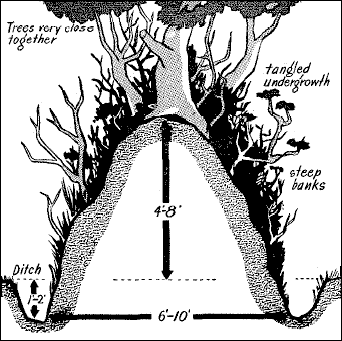![]()
![]()
OK Listen Up or Read on as the case may be.
Another History 101 Lesson:-(No Quiz on this one)
FIGHTING IN NORMANDY
Bucking the Hedgerows The terrain in the area selected for the initial penetration of French soil was generally level or gently sloping. However, it was broken up into a "crazy quilt" pattern of small fields separated by "hedgerows." These consisted of an earthen mound or wall 8 to 10 feet in width and 4 to 6 feet in height, covered with a scrub undergrowth. (See Below)
Along the top of this wall grew rows of trees. Forming an important part of the obstacle thus created was the ditch which ran along one or both sides of the mound. The roads, narrow and winding, ran between these hedgerows, and offered the defenders many advantageous positions for ambuscades or surprise attacks on advancing foot-troops and armor. Observation was normally limited from one hedgerow to the next, although an occasional structure, such as the church tower in a village would widen the horizon.
These peculiarities of terrain led to the development of special operational techniques in the application of tactical principles. Quoted below are some experience reports, from the battlefield, of hedgerow fighting.
The German Defense Ever since August 1940 the Germans have been studying and organizing the beach defenses of the French coast. They are past masters of the art of utilizing the terrain to advantage.
As set forth in a letter from the Commanding General, U. S. XIX Corps: "The Germans have been thorough in their defense. Their weapons are normally sited to provide long fields of fire. The 88-mm dual purpose gun, the ‘Tiger’ tank with its 88-mm gun, or the ‘Panther’ tank which has a 75-mm high-velocity gun, normally takes you under fire at ranges up to 2,000 yards. All weapons are well dug in. The mobility of their tanks is often sacrificed in order to secure the protection of a ditch or the walls of a building.
Sniper Trouble "The German soldiers had been given orders to stay in their positions and, unless you rooted them out, they would stay, even though your attack had passed by or over them. Some of their snipers stayed hidden for 2 to 5 days after a position had been taken and then ‘popped up’ suddenly with a rifle or AT grenade launcher to take the shot for which they had been waiting.
"We found fire crackers with slow burning fuse left by snipers and AT gun crews in their old positions when they moved. These exploded at irregular intervals, giving the impression that the position was still occupied by enemy forces.
"High losses among tank commanders have been caused by German snipers. Keep buttoned up, as the German rifleman concentrates on such profitable targets. This is especially true in villages. After an action the turret of the commander’s tank is usually well marked with rifle bullets.
Enemy in Ambush "On several occasions the Germans have allowed small patrols of ours to enter villages and wander around unmolested, but when stronger forces were sent forward to occupy the village they would encounter strong resistance. The Germans will permit a patrol to gather erroneous information in order to ambush the follow-up troops acting on the patrols' false report."
German Weapons One infantry regimental commander has given a good detailed description of the defensive organization: "We found that the enemy employed very few troops with an extremely large number of automatic weapons. All personnel and automatic weapons were well dug in along the hedgerows in excellent firing positions. In most cases the approaches to these positions were covered by mortar fire. Also additional fire support was provided by artillery field pieces of 75-mm, 88-mm, and 240-mm caliber firing both time and percussion fire. Numerous snipers located in trees, houses, and towers were used.
Our Attack "The most successful method of dealing with these defensive positions was the closely coordinated attack of infantry and tanks, with artillery and 4.2-inch chemical mortars ready to assist where needed. The use of these supporting weapons was severely handicapped by the limited observation."
I think you can get a very good picture of what we faced at age 18/19.
Yikes I coulda got hurt!!
This is an important visual in looking at Normandy Combat

Sgtleo



